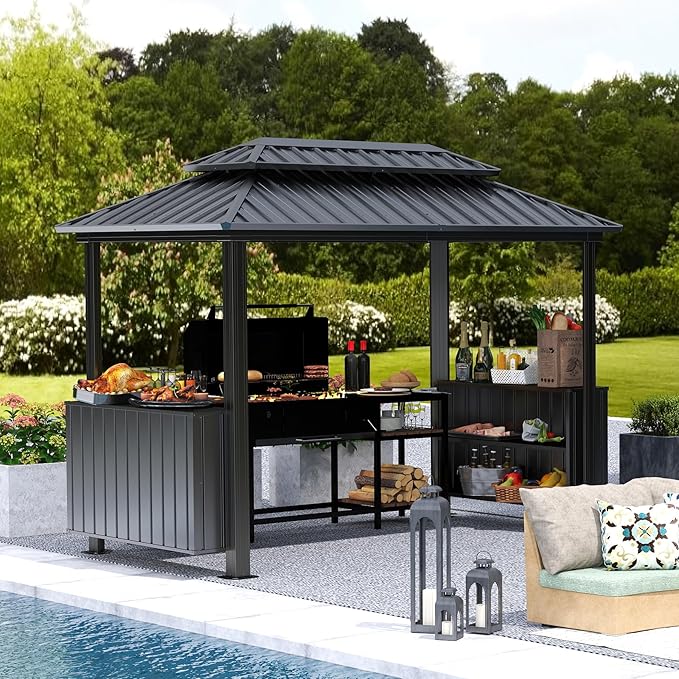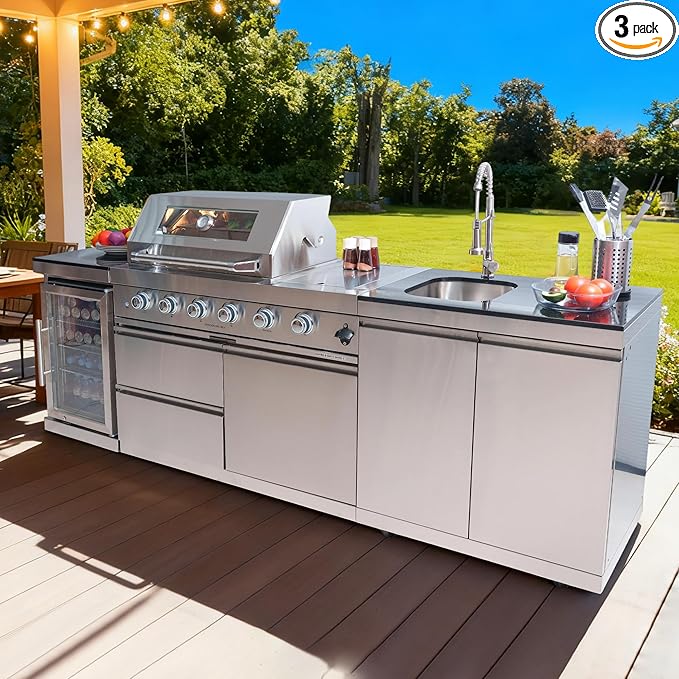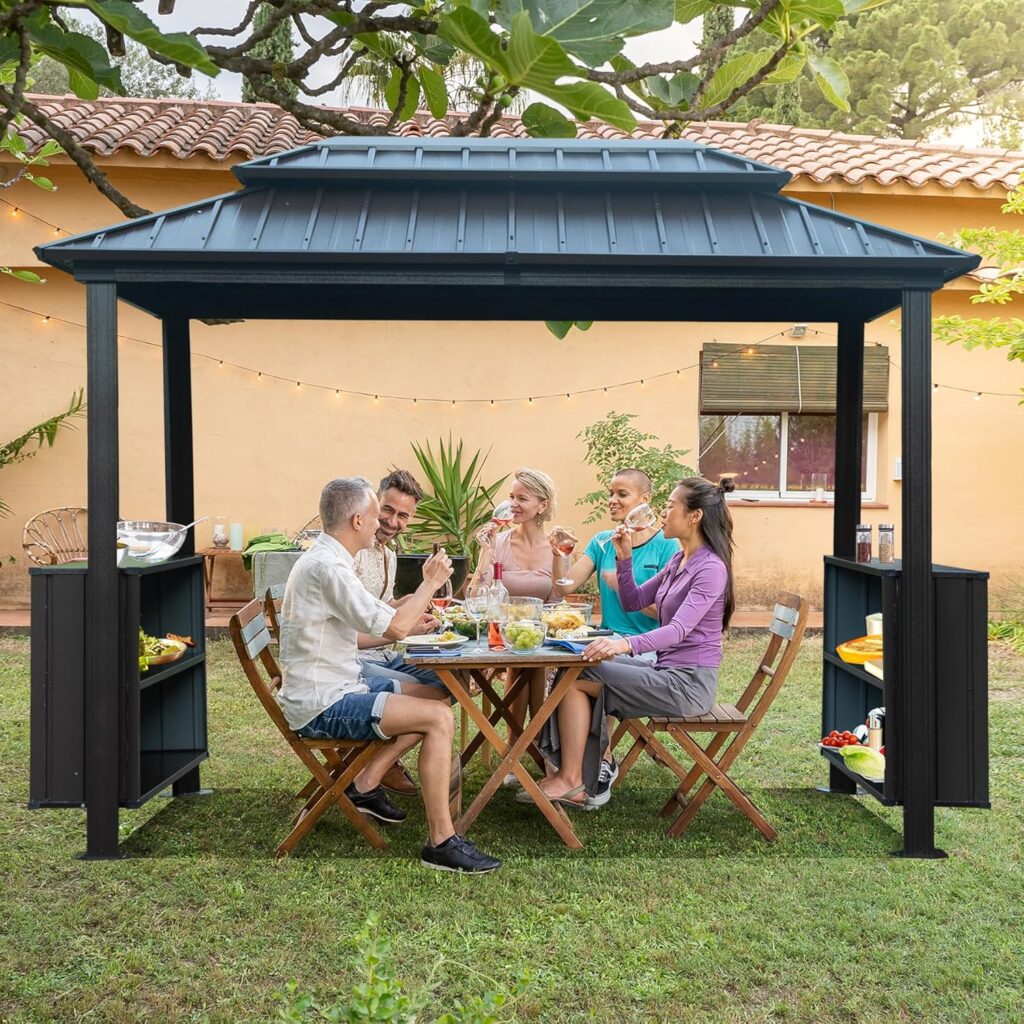
As temperatures drop and nights grow longer, most people pack up their grills and retreat indoors. But what if the cold season could be the best time to cook outside? Imagine standing in your backyard, a light snow falling, and the warm sizzle of food on a gas griddle filling the air. Winter grilling is not only possible — it’s a unique experience that brings flavor, warmth, and community to the colder months.
A gas griddle makes winter outdoor cooking easier, faster, and more enjoyable. Its even heat, weather-resistant design, and versatility allow you to prepare comfort food without worrying about flare-ups or uneven cooking. From hearty breakfasts to sizzling steaks, a gas griddle transforms your patio into a year-round kitchen.
If you’ve ever wondered whether outdoor cooking is worth the effort in cold weather, this guide will show you why a gas griddle is the secret to winter dining done right.
What makes a gas griddle ideal for winter cooking?

Cooking outdoors in winter has its challenges—wind, cold air, and unpredictable temperatures. Yet, gas griddles are made to handle it all. Unlike traditional grills with open grates, a griddle has a solid flat surface that retains and spreads heat evenly, even in freezing conditions. This means your food stays warm, and you can cook efficiently no matter the weather.
Gas griddles are ideal for winter because they heat evenly, resist wind interference, and maintain stable temperatures. Their stainless steel or cast iron plates hold heat longer than grill grates, making them perfect for cold climates. Plus, they require less preheating time, allowing you to start cooking faster.
Why heat distribution matters
In cold weather, uneven heat can ruin a meal. A griddle’s flat surface solves that problem by spreading warmth evenly. It also prevents heat loss from wind, ensuring food cooks thoroughly without drying out.
| Feature | Traditional Grill | Gas Griddle |
|---|---|---|
| Heat Distribution | Uneven, depends on flame exposure | Uniform across surface |
| Wind Resistance | Easily affected by wind | Wind-resistant |
| Preheating Time | Long | Short |
| Cooking Versatility | Limited | Multi-purpose |
Winter cooking should be comforting, not complicated. With a gas griddle, you get the same sear and taste as summer grilling — without battling the elements.
How does a gas griddle work in cold weather?
A gas griddle operates using propane or natural gas burners positioned directly under a thick metal plate. This plate stores and transfers heat to the cooking surface, providing even warmth for food. In cold weather, this mechanism becomes even more effective because it minimizes heat loss.
Gas griddles perform well in winter because their metal plates retain heat and resist cooling from cold air. The burners work steadily under the surface, maintaining temperature even when it’s windy or snowy outside. Most models include independent heating zones, allowing you to adjust sections for different foods at once.
Key design features for cold climates
- Thick steel or cast iron plate: stores heat longer
- Wind-blocking sides: reduce temperature loss
- Multiple burners: provide consistent, adjustable warmth
- Lids or covers: help trap heat for faster cooking
A gas griddle turns winter into a chance to enjoy hearty meals outdoors without fussing over flames or smoke. It’s reliable, steady, and perfect for both everyday meals and weekend gatherings.
Can you use a gas griddle during snow or rain?

Many assume that outdoor cooking stops once the snow starts falling. But a well-built gas griddle says otherwise. Its design allows safe and efficient operation even in damp or snowy weather.
Yes, you can safely use a gas griddle during light snow or rain if it’s sheltered and properly maintained. Griddles made from stainless steel resist rust, and the heating elements are usually protected under the cooking plate. With a sturdy lid or a small canopy, you can cook comfortably outdoors all winter long.
Safety tips for winter griddling
- Keep your griddle under a covered patio or awning
- Use weatherproof gas connections
- Wipe off snow or moisture before igniting
- Always preheat longer in colder temperatures
| Weather | Recommendation |
|---|---|
| Light snow | Safe to cook with proper cover |
| Light rain | Use under shelter |
| Heavy snow or storm | Avoid use until weather clears |
Cooking in snow gives a cozy atmosphere that’s unmatched indoors. The sizzling food against the cold air creates an experience that feels both rustic and rewarding.
What foods are best to cook on a winter griddle?
Winter is the season for comfort food. A gas griddle gives you a wide surface to prepare meals that warm both body and soul.
The best foods for winter griddle cooking are hearty and warming dishes like breakfast platters, seared meats, and stir-fried vegetables. You can also cook pancakes, grilled cheese sandwiches, bacon, or even soups in a pan set right on the griddle.
Winter griddle favorites
| Category | Example Dishes |
|---|---|
| Breakfast | Pancakes, eggs, bacon, hash browns |
| Lunch | Grilled cheese, quesadillas, burgers |
| Dinner | Steaks, chicken, shrimp, stir-fried noodles |
| Snacks | Roasted chestnuts, toasted sandwiches |
Winter griddling encourages creativity. You can cook entire meals on one surface, keeping food hot and fresh even as you chat by the fire pit.
How do you keep your griddle warm in winter?
Cold temperatures can cool metal surfaces fast. That’s why keeping your griddle at a steady temperature is key for great results.
To keep a gas griddle warm in winter, use a lid, set burners to medium-high, and preheat for at least 10–15 minutes. The metal retains heat, but cold air can cause uneven spots if not managed properly.
Practical tips:
- Use a griddle cover or wind guard
- Avoid placing the griddle directly in the wind
- Let it warm up longer than in summer
- Keep food near the center of the surface for even heating
If you have a multi-zone griddle, use one side for cooking and the other for keeping food warm. This method ensures every dish reaches the table at the perfect temperature.
Is a gas griddle better than a charcoal grill in winter?
Charcoal grills are great in summer but tricky in cold months. Lighting charcoal in freezing air takes longer, and maintaining heat requires constant monitoring.
A gas griddle is better for winter cooking because it heats faster, resists wind, and delivers stable temperature control. Charcoal struggles in low temperatures, while gas burners perform reliably with a simple ignition.
| Feature | Charcoal Grill | Gas Griddle |
|---|---|---|
| Setup Time | Long | Short |
| Temperature Control | Difficult | Precise |
| Wind Resistance | Poor | Strong |
| Cleanup | Messy | Easy |
| Fuel Use | High | Efficient |
The simplicity of turning a knob and getting instant heat makes gas griddles the smarter winter option. You spend less time managing flames and more time enjoying food with friends.
What maintenance does a gas griddle need in cold months?
When temperatures drop, moisture and frost can harm outdoor equipment. Proper care ensures your griddle lasts for years.
Winter maintenance includes cleaning, oiling, covering, and storing your griddle correctly. After each use, scrape off food residue, apply a thin oil layer to prevent rust, and cover the surface with a waterproof lid.
Winter care checklist
- Clean the surface after each use
- Dry completely to avoid corrosion
- Apply cooking oil to form a protective layer
- Use a fitted cover to shield from snow or dust
- Disconnect gas supply if not in use for long periods
Taking a few extra minutes for care will keep your griddle looking and working like new, even through the harshest winter months.
How can a griddle improve your winter outdoor gatherings?

Food brings people together, no matter the season. A gas griddle allows you to host outdoor brunches, dinners, or late-night snacks even when it’s cold.
A griddle enhances winter gatherings by creating a social, hands-on cooking experience. Guests can stand around, chat, and even help with cooking. It’s interactive, cozy, and full of warmth—both literal and emotional.
Fun winter gathering ideas:
- Weekend pancake breakfasts
- Backyard hot sandwich nights
- Holiday burger cookouts
- Stir-fry parties under fairy lights
Hosting with a gas griddle isn’t just about food; it’s about connection. The sight and smell of sizzling meals under a cold sky make for lasting memories.
What safety tips apply to winter griddle cooking?
Safety always comes first, especially with outdoor gas appliances.
Key winter safety tips: keep your griddle stable, use it outdoors only, and never leave it unattended. Cold weather can make surfaces slippery, and propane lines may stiffen in low temperatures.
Quick safety guide:
- Check gas lines for cracks or frost buildup
- Keep a fire extinguisher nearby
- Avoid enclosed spaces to prevent gas buildup
- Never move a lit griddle
- Let the griddle cool before covering
A few small precautions make outdoor cooking worry-free, ensuring safety and fun go hand in hand.
Conclusion
Winter doesn’t have to mean the end of grilling season. A gas griddle gives you the power to cook outdoors anytime, from snowy breakfasts to holiday feasts. Its even heat, easy maintenance, and versatility turn your backyard into a warm retreat during the coldest months.
So this winter, don’t pack away your cooking spirit. Fire up the griddle, invite some friends, and make your backyard the coziest kitchen in town.
Frequently Asked Questions
Can I leave a gas griddle outside all winter?
Yes, you can leave it outside as long as you cover it with a weather-proof cover, disconnect the gas if unused, and keep it dry to protect from rust and damage.
Does a gas griddle work well in freezing temperatures?
Yes, it works well because the flat cooking plate retains heat and the burner system maintains cooking temperature even when ambient air is very cold.
Will cooking on a griddle in winter cost more fuel?
Not significantly. While you may need a slightly longer preheat time, the efficient heat transfer of the griddle surface means fuel usage stays low compared to longer flame time on traditional grills.
Is it safe to use a gas griddle under light snow or in wet conditions?
Yes, it is safe if placed under a canopy or protected area and the gas connections are dry and clear of ice. Always check for snow buildup and keep the burner area clean.
What kind of foods are best for winter griddle cooking?
Comfort foods work great: pancakes, seared steaks, hash browns, stir-fried veggies, grilled sandwiches. The large even surface makes cooking multiple items easy and quick.
How should I maintain a griddle after winter cooking sessions?
After each use scrape off residue, apply a thin layer of oil to the surface, clean and dry the unit, and cover it. In winter, disconnect propane if unused and ensure no snow or water pools on it.
Can a gas griddle replace a charcoal grill for winter use?
Yes, it can replace many winter grilling tasks. Although you’ll miss the smoky flavour of charcoal, the griddle offers faster heat-up, better wind resistance and more consistent cooking in cold weather.
Do I need a dedicated wind guard or lid for winter griddling?
It’s highly recommended. A lid or wind guard helps prevent heat loss and wind interference, which is especially important in cold months to maintain consistent temperature on the cooking surface.
